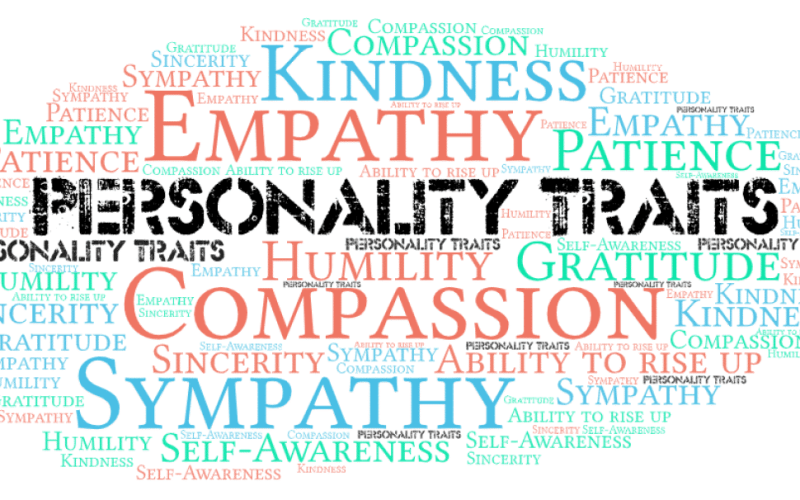Your personality is what defines you and sets you apart from others. It includes your preferences, behaviour and mannerisms. The combination of these factors can influence your hobbies, career, friendship and relationships.
Several trait personality theories have attempted to list out exactly how many personality traits exist. Previous theories have suggested several possible traits; Hans Eysenck’s three-factor theory, Raymond Cattell’s 16 personality factor, and Gordon Allport’s list of 4,000 personality traits.
However, many psychologists felt that Eysenck’s theory was too limited in scope, and Allport’s was too complicated. These observations gave birth to the five-factor model, which describes the major traits that serve as the foundation of personality.
What are the big five personality traits?
There are five core personality traits, according to most contemporary psychologists. These personality dimensions are also called the “big 5” or the Five-Factor Model (FFM).
The Five-Factor Model represents five key personality traits shortened to the acronym OCEAN for easy memorising.
- Openness
- Conscientiousness
- Extraversion (or sometimes spelt extroversion)
- Agreeableness
- Neuroticism
Some individuals prefer to memorise the traits using the acronym CANOE.
- Conscientiousness
- Agreeableness
- Neuroticism
- Openness
- Extraversion
It is worthy to note that each of the core personality traits represents a range between two polar ends. For instance, extraversion represents behaviours that fall anywhere between extreme extraversion and extreme introversion.
In real life, most people fall somewhere in between the two extreme ends of each dimension.
What does openness mean?
This dimension has to do with a sense of curiosity about other people and the world.
High score
- People who are high in this trait tend to
- Open to new ideas
- Be more creative and imaginative
- Enjoy trying out new things and experiences
- Easily adapt to change
- Enjoy thinking about abstract concepts
Low score
Individuals on the low end of this trait tend to
- Avoid change
- Dislike new concepts and ideas
- Be more traditional in thinking
- Not very imaginative
- Dislikes thinking about abstract or theoretical concepts
Scoring high in openness means you have a broad range of interests. You may enjoy using new methods to solve problems and find it easy to view things from different perspectives. Your openness to new ideas makes it easier for you to adapt to changes.
Just make sure to watch out for any situations where you might need to set up boundaries, whether that be in your workplace or with family members.
Individuals with a low openness score tend to be seen and traditional and straightforward in conceptual thinking. People perceive them as grounded and down-to-earth.
What does conscientiousness mean?
This trait describes a goal-oriented and conservative nature.
High score
A highly conscientious person tend to
- Be persistent
- Come prepared to work or school
- Pays attention to detail
- Are goal-driven
- Finishes important tasks on time
Low score
People who score low on conscientiousness are
- Impulsive
- Less organised
- Tend to procrastinate important tasks
- Take things as they come
- Dislikes schedules and structures
People who are highly conscientious love to keep to programs, time and paying attention to details. They love weighing their options and work hard to achieve their goals.
Friends and colleagues may see you as a reliable and fair person. You may likely micromanage tasks or situations. However, you might appear guarded and difficult to please.
Persons who score low on the conscientious scale tend to be less organised and prefer settings or situations without rules and schedules. They love doing things at their own pace and dislikes keeping to deadlines.
Friends and coworkers may see them as unreliable.
What does extraversion (extroversion) mean?
This dimension refers to people who draw energy from social interactions.
High score
People who score high on the extroversion scale tend to
- Easily make friends
- Seek excitement and adventure
- Draw attention to themselves
- Talk without thinking
- Are conversation starters
Low score
Scoring low on extra version can mean you
- Enjoy solitude
- Avoid large crowds
- Avoids being the centre of attraction
- Thinks before speaking
- Find it difficult to initiate conversations
- Feel exhausted after socialising
People on the high end of the extroversion scale are considered extroverts. They’re characterised by sociability, assertiveness, talkativeness and high amount of emotional expressiveness.
Often referred to as the life of the party, highly extraverted people tend to they feel excited and energised when they’re around people. However, they may find it difficult to be alone for long periods.
People who are low in extraversion are considered introverts; they’re more reserved and tend to keep to themselves.
Introverted persons love spending time with small groups or close friends and often require a period of quiet and solitude to recharge after involving in social events.
What does agreeableness mean?
This personality dimension entails the desire to keep things running smoothly.
High score
Scoring high in agreeableness means you possess the following qualities
- Honest and caring
- Always ready to lend a helping hand
- Are interested in the happiness of others
- Believe the best about others
Low score
People on the low end of agreeableness tend to be
- Self-centred
- Stubborn
- Belittles and insults others
- Doesn’t care for other people
- Manipulates people to get what they want
- Cares and contributes little to the happiness of other
People on the high end of agreeableness are accommodating and cooperative. People see you as trustworthy and always turn to you for assistance.
However, you might trust too much or be willing to compromise. Try to quench your hunger for pleasing others with self-advocacy.
People on the other end of agreeableness are characterised by competitive and sometimes, manipulative behaviours. You might tend to be less sympathetic and hold grudges when offended.
The upside of being on the low end, however, is that you are more likely to avoid the deathtrap of comparing yourself to others or give ear to what others say about you.
What does neuroticism mean?
This trait is characterised by the tendency to have unsettling feelings and thoughts.
High score
People on the upside of neuroticism tend to
- Often feel insecure or vulnerable
- Experience dramatic mood swings
- Struggle with difficult situations
- Get stressed easily
- Feel anxious
Low score
A low score in neuroticism can mean you
- Are emotionally stable
- Worry less
- Are more optimistic
- Rarely feels depressed or sad
- Are capable of handling stressful situations
A high neuroticism score means you tend to blame yourself when things go wrong. You may easily get frustrated with yourself, especially if you make a mistake. Also, chances are you’re prone to worrying.
However, you may be more reflective than others, which enables you to examine and better understand your feelings.
People on the low end of neuroticism are confident. Being emotionally resilient comes to you quickly, and you find it easy to keep your cool when under pressure or stress.
You might also find it easier to relax. However, it may not be as easy for the people around you, so be patient.
How do I know which personality best describes me?
There are a variety of websites that offer different versions of the big five personality traits test. The Big Five Inventory is one popular option. This method uses your answers to about 50 short phrases and statements.
For each question or phrase, you are to agree or disagree on a scale of 1 to 5. It then shows you where you fall on a spectrum for each dimension based on your responses. For instance, you may score high in conscientiousness and low in agreeableness.
It is important to note, however, that personality is extremely complex. There is no good or bad trait, and each attribute has its unique strengths.
The result of your test isn’t a definitive statement about your personality. They may even be affected by a variety of factors ranging from your mood that day to whether you have an upcoming event to plan for or a tight deadline to beat.
How reliable is the five-factor model?
Since its inception in the early 1990s, the Five-Factor Model has been used widely by business professionals, researchers and others. This is partly because of its effectiveness.
While personality development is a continuous process, a 2011 study reported that the Big Five personality dimensions, in general, tend to be stable over four years, once you attain adulthood. Any other change that occurs is usually small and gradual.
Plus, researchers have found that the five-factor model is remarkably universal. A study on 50 participants from different cultures recorded that the five dimensions – to some extent – could be used to describe personality across these cultures.
Some cultures may view some traits as more important than others, and some cultures may regard other dimensions that this model doesn’t measure. But in general, this model is considered universally applicable.
Bottom line
Personality dimensions are incredibly complex, and these tests can sometimes help you understand the traits you possess. However, they can’t completely define who you are as a person. Even if it gets some things right, a test can never fully describe you.
If you feel one of your traits is negatively affecting your relationship, or you’ll like to work on a specific behaviour or feeling, you can always seek help from a therapist or counsellor.
A therapist can assist you in learning more about your personality and try out ways to achieve any changes you’ll like to make.
References;
- Universal Features of Personality Traits From the Observer’s Perspective: Data From 50 Cultures. PsycNet
- Long‐term stability in the Big Five personality traits in adulthood. Wiley Online Library
- Neuroticism. Britannica
- Terracciano, A., & McCrae, R. (2006). Cross-cultural studies of personality traits and their relevance to psychiatry. Epidemiologia E Psichiatria Sociale, 15(3), 176-184. Doi:10.1017/S1121189X00004425
- Rantanen J, et al. (2007). Long-term stability in the Big Five personality traits in adulthood. DOI:10.1111/j.1467-9450.2007.00609.x








